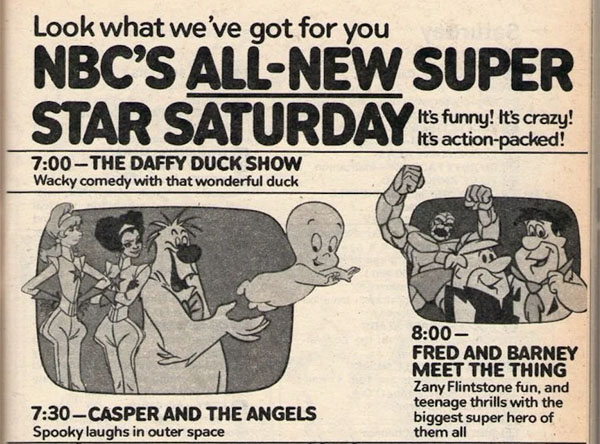
For Hanna-Barbera, 1979 was a time of some offbeat “mash-ups.” Like Fred and Barney Meet the Shmoo, which debuted that same year (and was discussed recently here), Casper and the Angels combined so much in one show and added a dash of a familiar, friendly ghost.
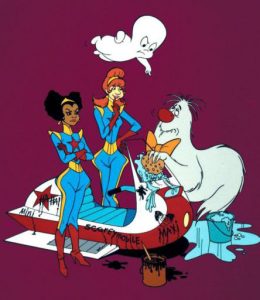 Although he was the lead, Casper (voiced by Julie McWhirter) materialized as a sidekick/guardian angel character to two female space police officers, Mini (Laurel Page) and Maxi (Diana McCannon), in a futuristic/Jetsons-ish science fiction setting, where they patrol in flying, motorcycle-like vehicles.
Although he was the lead, Casper (voiced by Julie McWhirter) materialized as a sidekick/guardian angel character to two female space police officers, Mini (Laurel Page) and Maxi (Diana McCannon), in a futuristic/Jetsons-ish science fiction setting, where they patrol in flying, motorcycle-like vehicles.
Casper also plays straight man to the comic relief, a scruffy-looking ghost named Hairy Scary (John Stephenson doing an Ed Wynn-inspired voice), who has a red, bulbous nose and sports an oversized bow tie.
Together, they embark on different adventures, from investigating something crooked at a space circus to finding themselves stranded when they take a new spaceship for a spin. Also on the show were Nerdly (Hal Smith) and Fungo (Paul Winchell), two male space police officers who constantly gave Mini and Maxi a hard time.
Casper and the Angels drew its influence from and combined concepts of shows and movies that were popular at the time – a little Charlie’s Angels, a little Laverne and Shirley, and a dose of Star Wars.
“The reality was–and is–that television, in particular, tends to embrace imitation,” said Greg Ehrbar, author of Hanna-Barbera: The Recorded History and host of The Funtastic World of Hanna and Barbera podcast. “Hanna-Barbera’s industry contemporaries did precisely the same thing elsewhere on the network schedules. Charlie’s Angels on ABC became Flying High on NBC and The American Girls on CBS, and that’s one of countless examples.”
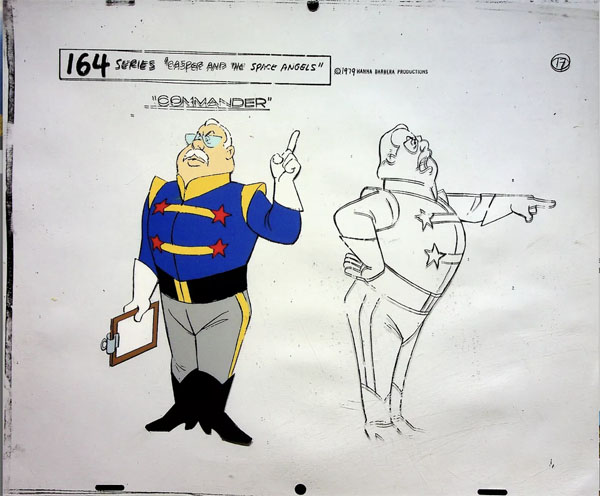
Casper and the Angels was a time capsule of when Saturday morning television changed. In their book, Saturday Morning Fever: Growing Up with Cartoon Culture, authors Timothy and Kevin Burke write, “The Seventies were the template for Saturday morning, but by the end of the decade, the formula was in danger of failing, both because of the repeated challenges of critics and because of internal pressures.”
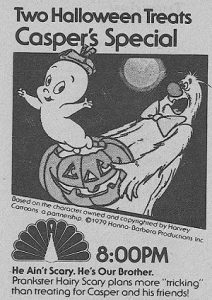 It was forty-five years ago this fall that Hanna-Barbera started producing Casper shows. In addition to Casper and the Angels, the friendly ghost starred in two prime-time specials produced by the Hanna-Barbera Studios, Casper’s Halloween Special and Casper’s First Christmas (1979).
It was forty-five years ago this fall that Hanna-Barbera started producing Casper shows. In addition to Casper and the Angels, the friendly ghost starred in two prime-time specials produced by the Hanna-Barbera Studios, Casper’s Halloween Special and Casper’s First Christmas (1979).
Of course, Casper had been around for decades before this, first appearing in Famous Studios’ 1945 short subject, The Friendly Ghost. He would go on to appear in over fifty theatrical shorts.
In his book Of Mice and Magic: A History of American Animated Cartoons, Leonard Maltin noted, “Casper, like a growing number of Famous cartoons, was aimed strictly at children – which limited its appeal in theaters but made it doubly marketable in other ways. Later, the Casper cartoons scored an even bigger hit on TV, to such a degree, that a new series of shorts was commissioned in the 1960s.”
Casper’s cartoons would be part of the TV shows Matty’s Funday Funnies (1959) and The New Casper Cartoon Show (1963).
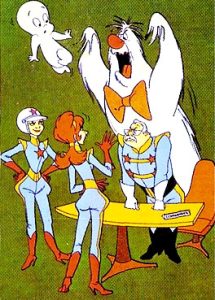 The shorts usually focused on Casper wanting to do more than scare people but inadvertently doing exactly that until he befriended someone who would accept him.
The shorts usually focused on Casper wanting to do more than scare people but inadvertently doing exactly that until he befriended someone who would accept him.
However, with Casper and the Angels, this plot paradigm changed. Here, Casper would embark on different adventures with the Angels.
Each episode would begin with quick strains of Casper’s theme song at the beginning and end of the opening credits, during which the instrumental theme would show scenes of the sci-fi escapades that were about to come. It was all a different setting from what audiences were used to from the friendly ghost.
“There were real-life reasons such convoluted concepts came to be,” explained Greg Ehrbar, “According to several people who were at the studio back then, it was due to the nature of television since the beginning and the nature of executive decision-making.
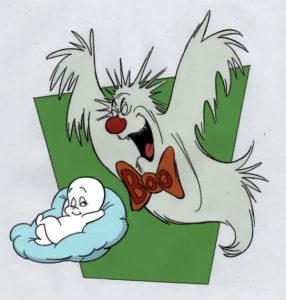 “Joe Barbera pitched three different series concepts, two based on current TV hits, Charlie’s Angels and CHiPs, and another starring Casper. Rather than choosing one, they chose a mix of all three. What the Hanna-Barbera studio had to its advantage was talented people who managed to somehow make it as entertaining as possible, even as the network, sponsors, and pressure groups had their say. Casper and the Angels was certainly not the only unusual series made during this frantic, bizarre, competitive era, but its head-scratching premise is well remembered.”
“Joe Barbera pitched three different series concepts, two based on current TV hits, Charlie’s Angels and CHiPs, and another starring Casper. Rather than choosing one, they chose a mix of all three. What the Hanna-Barbera studio had to its advantage was talented people who managed to somehow make it as entertaining as possible, even as the network, sponsors, and pressure groups had their say. Casper and the Angels was certainly not the only unusual series made during this frantic, bizarre, competitive era, but its head-scratching premise is well remembered.”
Casper and the Angels features work by many tremendous animation-industry talents, including Robert Alvarez, Ed Barge, Gabor Csupo, Hugh Fraser, Robert Gentle, and Phyllis Craig.
Debuting on September 22, 1979, the series would last only half a season until December 15, 1979. Casper would return in other animated series, and most notably on the big screen, in 1995’s live-action/animated feature.
There’s a good chance that Casper will magically reappear again someday, adding to his animated history, which includes a stint with Hanna-Barbera that reflects so much that was popular in 1979.


 Michael Lyons is a freelance writer, specializing in film, television, and pop culture. He is the author of the book, Drawn to Greatness: Disney’s Animation Renaissance, which chronicles the amazing growth at the Disney animation studio in the 1990s. In addition to Animation Scoop and Cartoon Research, he has contributed to Remind Magazine, Cinefantastique, Animation World Network and Disney Magazine. He also writes a blog, Screen Saver: A Retro Review of TV Shows and Movies of Yesteryear and his interviews with a number of animation legends have been featured in several volumes of the books, Walt’s People. You can visit Michael’s web site Words From Lyons at:
Michael Lyons is a freelance writer, specializing in film, television, and pop culture. He is the author of the book, Drawn to Greatness: Disney’s Animation Renaissance, which chronicles the amazing growth at the Disney animation studio in the 1990s. In addition to Animation Scoop and Cartoon Research, he has contributed to Remind Magazine, Cinefantastique, Animation World Network and Disney Magazine. He also writes a blog, Screen Saver: A Retro Review of TV Shows and Movies of Yesteryear and his interviews with a number of animation legends have been featured in several volumes of the books, Walt’s People. You can visit Michael’s web site Words From Lyons at: 






















I have elsewhere mentioned that as a college student, one of my class assignments was to report on mainstream Saturday morning cartoons, so I got into a regular habit of watching for a few weeks. One of the themes that I dealt with was “new wrinkles on old favorites” which at the time included both shows referenced at the top of this article.
Casper and the Angels was, as I recall, rather engaging and delightful. I felt that Casper had good rapport with his female co-stars and Harry Scary was a good foil for the friendly ghost. I don’t recall specific episodes, but I do remember being somewhat interested and fascinated by this revival of the classic character. The show gave off positive vibes.
And Casper’s First Christmas has become part of my regular holiday viewing. Casper’s initial meeting with Yogi Bear and Boo Boo is priceless, especially in light of the numerous times in previous outings when the only reaction Casper ever got was “A g-g-ghost!” At least Yogi and Boo Boo were willing to listen to reason and give Casper a chance to prove his friendship. I enjoy seeing Casper’s interaction with the classic Hanna-Barbera bunch. The special, to me at least, has a lot of heart. And Hairy Scary proves he’s not such a bad guy after all.
Wait, Gabor Csupo worked at H-B before setting up his studio (which would be a powerhouse for Nickelodeon)? That’s probably the most interesting thing about this show.
I was thinking the same the minute I saw Gabor Csupo’s name. I didn’t know about any of his work prior to The Simpsons or his contributions to Nickelodeon, but it’s interesting to know he’s done some work on a Hanna Barbera production.
It probably didn’t help that at this point, NBC’s ratings across the board, with the exception of “The Tonight Show,” were absolutely awful. Culminating in the fiasco that was the 1980 Summer Olympics situation, and the wholesale massacre of NBC’s prime-time lineup (Johnny Carson noting that NBC now stood for “Nine Bombs Cancelled”).
Old joke: Casper was busted for sexual harassment [of one of the Space Angels?]. In his defense, he merely said, “Golly, I was only trying to be friendly.” The case was dismissed, however, because during voir dire prospective jurors kept shouting “A g-g-ghost!” and fleeing the courtroom.
Anybody here remember “The Duck Factory”? The head of a struggling animation studio pitches a series to a network executive. Noticing the “Star Wars” stuff all over the office, he hastily resets it in outer space.
One suspects there were a lot a meetings that played out that way, when a studio had a property but that wasn’t enough to close the deal. “We got the Three Stooges. And they … they’re like the Six Million Dollar Man’ …”
Both “Wacky Races” spinoffs were rooted in decidedly cooled-off pop culture: Penelope Pitstop referenced silent movie serials while Dick Dastardly evoked WWI flying ace epics. Did Joe Barbara find himself pitching to a geriatric exec?
I have wondered about the retro nature of those “Wacky Races” spinoffs. Of course, by that time Snoopy had popularized WWI with the younger set and I believe revival movie houses were occasionally running silent movies and old serials, so young folks were not totally unaware of the ghosts of entertainment past. But still, to develop two entire series based on bygone pop culture seems a bit of a risk even for those times.
The answer is that retro culture worked well on those days and Wacky Races was a sort of parody of The Great Race (launching Muttey’s career as a Peter Falk imitator- later on he went on his own Columbo show, with a little change on his name). Retro culture was in the air since Norma Desmond days. Or the Dover Boys…
7:30 AM! On a Saturday? No kid in his right mind would get up that early on a Saturday unless he had to. No wonder I never heard of this. It does sound like a great time capsule, however. Thanks for the writeup.
A quick look at a collation of US network TV schedules seems to show that Casper went to 11:00 from December to April, then back to 7:30. Because if a network executive isn’t moving shows around the schedule, what justifies the high salary? (After the new episodes competing against “The World’s Greatest Super Friends” and “The New Adventures of Mighty Mouse and Heckle & Jeckle,” the reruns went against reruns of “Scooby Doo and Scrappy Doo” or “The All New Popeye Hour.”)
Here’s a scheduling question: while 13 episodes is on the short side for a cartoon series, it’s unfair to call that “half a season.” Other serieses had runs of 15 or 16, or, most commonly, at least among the series of my interests, 17 episodes. (The Popeye Hour of 1979 appears to be a high outlier with 24.) At some point it struck me that 3 * 17 = 51, and that a series could have its first run and two rerun cycles in the 52 Saturdays of a year. Three airings of each series on the three networks… coincidence? Someone with access to more detailed scheduling information would have to confirm that. There’s also a question to be answered about shows getting a second season: it was in most cases fewer new episodes, to my eyes it looks like enough for a run of the new, then two reruns of what DVD boxes call “The Complete Series,” but was that actually the case?
Jack, I don’t actually understand what your question is… but you are correct about the first run (first season) order of 17 episodes (or so) being designed so the show would rerun four times over a year (until the next September).
Second seasons are another story. With a few exceptions (like Scooby Doo), most “second season” orders were only a token six episodes, just enough for the network to advertise “all-new” episodes – for a month! A true, full-order (17 episodes) “second season” would be more like what happened with Josie and The Pussycats, which became Josie and the Pussycats In Outer Space in its second season… some sort of new way to do the same show (other examples include The Archie Show becoming The Archie Comedy Hour, Archie’s Fun House and Archies TV Funnies, etc. in subsequent seasons; The Pink Panther Show also went on to be under numerous titles throughout the years, etc.)
Were studios thinking of post-network syndication for Saturday morning shows? That generally requires enough episodes to sustain a Mon-Fri time slot (65 episodes = 13 weeks), but as you explain it was extremely rare for a series to log more than 20. Guessing they couldn’t get networks interested in buying longer seasons, or perhaps nobody believed Space Ghost or Alvin had any serious shelf life.
I can recall seeing odd episodes of former Saturday morning shows on Sundays, but almost never in the kind of heavy rotation old sitcoms enjoyed.
The Flintstones racked up plenty of episodes because of long prime-time seasons, but otherwise you only saw those numbers in shows created expressly for Mon-Fri syndication (Was Rocky and Bullwinkle the first?).
No. They provided the networks with what they asked for. If the budget was for 17, they got seventeen.
Two years before our family purchased a VCR, yours truly was a high school sophomore who gladly arose every Saturday at 5:30 AM to catch the hour block of “Bullwinkle” reruns airing on one of the local channels.
No VCR at my house either when I was young, but I was SO lucky that Rocky and Bullwinkle had one rerun that played Sunday mornings right after we were forced to go to church. So that was the silver lining of having to get up on a Sunday morning (wasn’t even that early).
Now that I think of it, Sunday morning seems a strange time to have any cartoons, and I don’t remember any others that played then.
Not that I’m claiming to be representative of kids of my era, but I got up at 6am every morning for Star Blazers and The Bullwinkle Show…
Personally, I believe Hairy Scary is more enjoyable in/on the Halloween and Christmas specials of Casper’s
I remember this, andc at 18 didn’t really care for anyone but really liked Hairy Scary.Too bad they couldn’t license Win Sharples’s stock music.:)
Steve C.
I still don’t understand why there isn’t a big budget Broadway musical based on “The Harlem Globetrotters on Gilligan’s Island”.